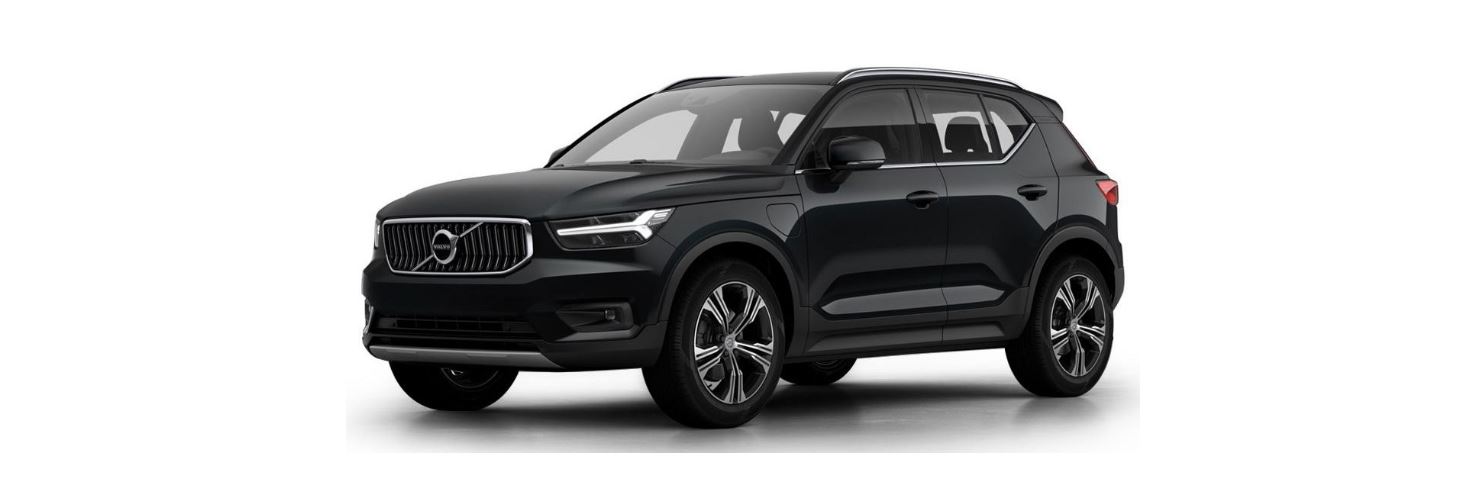- Do not affix any objects, tape, or decals in the areas described below.
- Clean camera lenses regularly with lukewarm water and car shampoo – be careful not to scratch the lenses.
- Avoid fitting auxiliary lamps or similar in the grille as this may affect the performance of the front radar unit.
- Use only Volvo genuine emblems in the grille in front of the front radar unit so as not to affect the function of the front radar unit.
Radar unit locations
Location of the parking sensors
Note
Dirt, ice, and snow covering the sensors may cause incorrect warning signals, and reduced or no function.
Camera location
Location of the camera unit
Important
Maintenance of driver support components must only be performed at a workshop – an authorized Volvo workshop is recommended.
Software updates
The car’s software is updated through its connection to the mobile network, which is designated OTA (over-the-air).
The notification view shows when a new software update is available. You can choose when to install it after it has been downloaded. Update the software in the car as soon as possible when an update is available.
Download
The download takes place in the background via the mobile network when the car is running. It may take several hours, depending on the size of the update and the speed of the connection. If the car is switched off while the download is in progress, it is resumed automatically the next time the car is started.
The following is required in order to download updates:
- the car is connected to the internet use of the Internet involves data transfer (data traffic), which may involve charges. Volvo meets the cost of data traffic for system updates unless a personal SIM card is installed.
- approval of the use of online services.
Note
Depending on the software version, a download may start automatically, or be started via the notification of an available software update.
Installing an update
Once a software update has been downloaded and is ready for installation, this is shown in the notification view and by a message when the car is started. You can choose to install the update immediately or have a further reminder at a later date.
Note
The installation of the software update may take up to 90 minutes. During this time, the car will be locked and its functions unavailable. Bear this in mind when scheduling the update.
During installation:
- The notification view shows when an update is ready for installation. Open the notification and follow the instructions in the center display.
- Leave the car, close all doors, and lock the car.
The installation is started. The car must be locked within several minutes otherwise the installation is canceled. - Wait until the installation is finished.
The installation may take up to 90 minutes. When the installation is finished the car can be used as normal.
Note
- If possible, avoid handling the car, its charging cable, and other functions during the installation.
- If you need to enter the car while installation is in progress, you must use the key blade.
- The car’s anti-theft alarm is disarmed during installation in order to avoid false alarms.
Always read through what the update contains so that you know how the car and its functions are affected.
If the installation fails, the car’s systems are reset to the latest installed version.
Note
It is important to install software updates as soon as possible in order to avoid the risks that may be associated with old software. If you experience problems with the update – contact your Volvo dealer.
Information on contents
Tap on the information symbol in the center display for more information on the content of the software update.
Note
Functionality after updating may vary depending on the market, model, model year, and options.
Brake system maintenance
Check brake system components regularly for wear.
To keep the car as safe and reliable as possible, follow the Volvo service intervals as specified in the Service and Warranty Booklet. After replacing brake linings and brake discs, the braking effect is only adopted after they have been “worn in” for a few hundred kilometers (miles). Compensate for the reduced braking effect by depressing the brake pedal harder. Volvo recommends only fitting brake linings that are approved for your Volvo.
Contact a workshop for information about the procedure or engage a workshop to carry out the inspection – an authorized Volvo workshop is recommended.
Operational disruption
Some functions have limitations in particular situations and require that certain conditions are fulfilled in order to work. The driver display and the center display may show messages in order to inform about such a situation.
Find out more about fault-tracing and the limitations of various functions in related articles below.
If the car is not drivable
Activate the hazard warning flashers if the car has broken down or been forced to stop unexpectedly in a trafficked environment. Think about safety. If possible, move the car out of danger from traffic. Put on a reflective vest and then position the warning triangle so that other road users are warned in good time. Call roadside assistance if the cause cannot be remedied at your location.
Data transfer between car and workshop via Wi-Fi
Volvo’s workshops have a specific Wi-Fi network for data transfer between the car and the workshop. The car is connected using the key’s buttons, so it is important to take along a key with buttons in the event of a workshop visit.
During a workshop visit, your service technician can perform fault-tracing and update software via the network.
When the car is connected to a Wi-Fi network, the symbol appears in the center display.
It is not possible to use the key to connect to other Wi-Fi networks.
WarningThe car must not be driven when connected to the workshop’s networks and systems.
Raise the car
It is important to use the correct lifting points on the car’s chassis when using a jack (Option/accessory.) to raise the car. Different lifting points are available depending on which type of lifting equipment is used. Read through all of the instructions before raising the car.
The car can be raised using a jack designed for short-term raising, using a garage jack if the car needs to be raised regularly, or by authorized workshop personnel that has access to larger lifting devices.
The normal car jack (Option/accessory. )is only designed for occasional, short-term raising, such as when changing a wheel after a puncture. If the car is to be jacked up more often, or for a longer time than is required just to change a wheel, a garage jack is recommended. In this instance, follow the enclosed instructions.
Warning
- The car must not be allowed to roll while it is being raised. Apply the parking brake and set the gear selector in the Park position (P).
- Chock in front of and behind the wheels that remain on the ground using solid wooden blocks or large stones.
- When changing a wheel, use a jack intended for the car model. Use additional stands to support the car for all other work.
- Do not use a jack in poor condition. Check that the threads are lubricated and that it is free of damage and dirt.
- Check that the jack is stable. The surface underneath must be firm, flat, and not slippery.
- Never position anything between the ground and the jack, or between the jack and the car’s lifting point.
- Never allow passengers to remain in the car while the car is being supported by the jack. Make sure that they are standing in a safe location if a wheel needs to be changed in a trafficked location.
- No part of your body may be extended under the car while it is raised on the jack.
Lifting points
Warning
If the car is raised with a garage jack then it must be positioned under the inner lifting points. Follow the instructions enclosed with the garage jack. Make sure that the jack is correctly positioned so that the car cannot slide off during lifting. Make sure the head of the jack is fitted with rubber guards so that the car remains stable and is not damaged. Use axle stands or similar when the car is in the raised position.
Lifting a wheel using a jack
Read through all instructions before beginning. Take out the tools needed before jacking up the car.
- Activate the hazard warning flashers if the car has to be raised in a trafficked location.
Set up the warning triangle. - Activate the parking brake. Select gear position P.
- Position chocks in front of and behind the wheels that remain on the ground. Use, for example, heavy wooden blocks or large stones.
- Position the jack under one of the car’s lifting points with the crank handle pointing straight out from the side of the car.
The positions of the outer lifting points are marked with triangular arrows along the lower edge of the side of the car. There are special notches for the head of the jack behind the markings. - Ensure that the jack is stable on flat firm ground and that the surface underneath is not slippery.
- Crank up the jack so that it makes contact with the car’s lifting point. Check that the edge of the lifting point is aligned with the slot in the head of the jack.
Check that the jack is completely vertical and at right angles to the side of the car.
The car is now ready to be raised.
Raise the car just high enough to carry out the work intended.
Lower the car using the jack immediately after the work has been completed.
When the jack (Option/accessory. )is not in use, it is recommended to store it in the car, protected from moisture and dirt.




